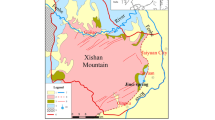Abstract
Jinci Spring is one of the most famous karst spring in Northern China and is the main drinking and irrigation water source of Taiyuan city, Shanxi Province. It has special significance in terms of humanities and water resources. Because of the continuous over-exploitation of groundwater, the water level of groundwater has been decreased significantly. The flow of Jinci Spring has decreased year by year since the 1970s, and in 1994 it cut off completely. The flow cutoff has brought huge losses to the local economy and negatively impacted the ecological environment. From the hydrogeological conditions of Jinci Spring area to study, the dynamic change in karst groundwater level will provide a basis for the protection and rational exploitation of karst water in the spring area. The previous research on Jinci Spring area was limited to the spring flow and water level changes, lack of analysis to the overall spring area and the decay process of spring flow. This paper takes the overall spring area as research object. According to groundwater level data over 1961–2012, the period is divided into two phases of decline and recovery. Human activities in the region and corresponding groundwater evolution at various stages were systematically analyzed, and the reservoir capacity was calculated for each period of decline. The results show that the average reservoir capacity decreased from 920 (1954–1960) to 116 (1961–1977) to 31 (1978–1994) million m3. The important effect of “Water Resumption” project on groundwater in the area during the remediation period was also analyzed. In the light of observed increases in groundwater level during this stage, the project has a notably positive effect.






Similar content being viewed by others
References
David, T. L., et al. (2012). Effects of human activities on karst groundwater geochemistry in a rural area in the Balkans. Applied Geochemistry, 27(10), 1920–1931.
Fan, J., et al. (2016). Prediction of groundwater level and flow of Jinci Spring based on gms and NCC/GU-WG. Water Resources and Power, 34(08), 36–39 + 53.
Feng, M., & Li, L. (2000). Influence of human activities on Jinci Spring and analysis of Jinci Spring reflow condition. Shanxi Science and Technology, 6, 52–54.
Gao, Z-P., et al. (2017). Study on spatial and temporal variability of groundwater and driving factors. Water Resources and Power, 35(06), 116–119 + 18.
Jian, Y., et al. (2016). The influence of groundwater environment and the protection measures of Jinci quan water supplement project. Design of Water Resources & Hydroelectric Engineering, 35(03), 20–22.
Kattaa, B., et al. (2010). Groundwater vulnerability assessment for the Banyas Catchment of the Syrian coastal area using GIS and the RISKE method. Journal of Environmental Management, 91(5), 1103–1110.
Lei, M., et al. (2017). Land use change and impact on groundwater storage in the Huang-Huai-Hai Plain. Resources Science, 6(39), 1099–1116.
Luan, Q., et al. (2015). Ecological influence and value evaluation of Fenhe River water diversion in order to reflow. YELLOW RIVER, 5(37), 62–65.
Ma, J. Z., et al. (2005). The characteristics of ground-water resources and their changes under the impacts of human activity in the arid Northwest China—A case study of the Shiyang River Basin. Journal of Arid Environments, 2(61), 277–295.
Noam, Z. D., et al. (2016). The effect of hydrogeological conditions on variability and dynamic of groundwater recharge in a carbonate aquifer at local scale. Journal of Hydrology, 4(535), 480–494.
Sun, C., Wang, J., & Lin, X. (2001). Reproducibility of Shanxi Jinci Spring under drinking water condition. Carsologica Sinica, 20(1), 11–16.
Takeshi, H., et al. (2009). Effects of human activities and urbanization on groundwater environments: An example from the aquifer system of Tokyo and the surrounding area. Science of the Total Environment, 9(407), 3165–3172.
Wang, B. (2015). Study on the principle of well water level accelerating rising around Jinci segment on Jiaocheng Fault Zones (pp. 24). Taiyuan: Taiyuan University of Technology.
Wang, D., et al. (2014). Contribution degrees of precipitation and groundwater exploitation to the groundwater flow field in Shijiazhuang. Advances In Water Science, 3(25), 420–427.
Xia, Q. (2011). Multi model analysis method for groundwater indeterminacy and its application (pp. 36–37). Beijing: China University of Geosciences.
Yang, Y., et al. (2017). Dynamic variational characteristic of shallow groundwater and its influencing factors in nearshore vegetable field of Erhai Lake. Journal of Irrigation and Drainage, 36(1), 1–8.
Yin, D. (2007). Research on reflowing condition of Jinci Spring in Shanxi Province. Jilin: Jilin University.
Yin, D., Su, X., & Li, X. (2006). Application of ANN technology in evaluation of karst groundwater exploitation quantity——A case study of Shanxi Jinci Spring area. Journal of Jilin University Earth Science Edition, 36, 55–59.
Zhang, P. (2016). Risk assessment of karst groundwater of Jinci Spring area. Taiyuan: Taiyuan University of technology.
Zhao, J. J. (2012). Analysis of the influence of human activities on the spring water flow in the Jinci Spring (pp. 28). Tianjin: Tianjin normal university.
Zhong, Y., & Zhang, Y. (2017). Three dimensional flow model of karst groundwater in Jinci Spring area and reflow scheme. Water Resources and Power, 9, 116–118.
Acknowledgements
This research was funded by the National Natural Science Foundation of China (Nos. NSCF-51609216 and NSCF-51379191). The authors are grateful to colleagues and friends who shared their meteorological and hydrological data with us. We also thank three reviewers for insightful comments that improved an earlier version of this manuscript.
Author information
Authors and Affiliations
Corresponding author
Rights and permissions
About this article
Cite this article
Lv, C., Ling, M., Wu, Z. et al. Analysis of groundwater variation in the Jinci Spring area, Shanxi Province (China), under the influence of human activity. Environ Geochem Health 41, 921–928 (2019). https://doi.org/10.1007/s10653-018-0189-6
Received:
Accepted:
Published:
Issue Date:
DOI: https://doi.org/10.1007/s10653-018-0189-6




